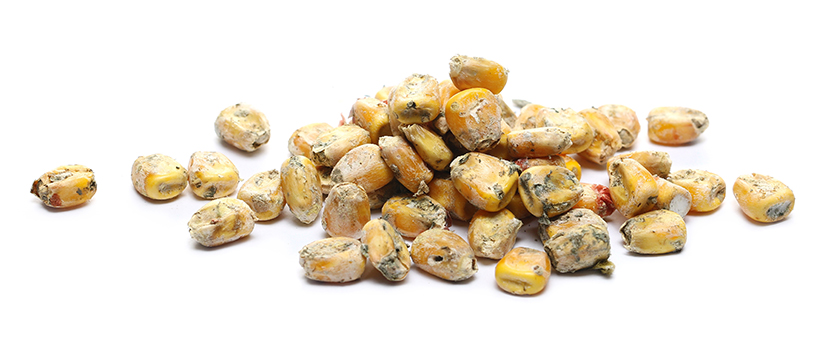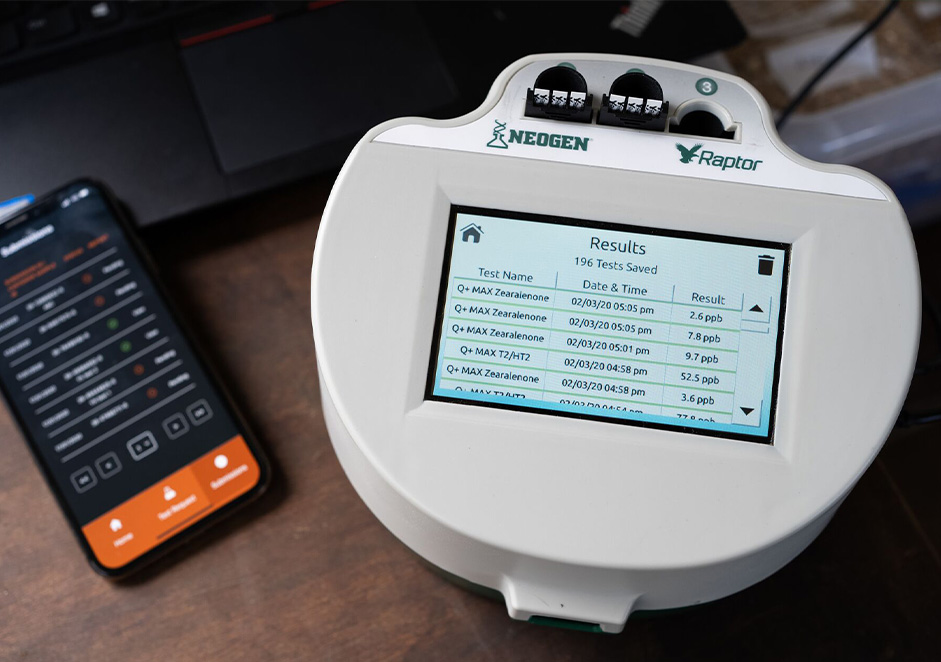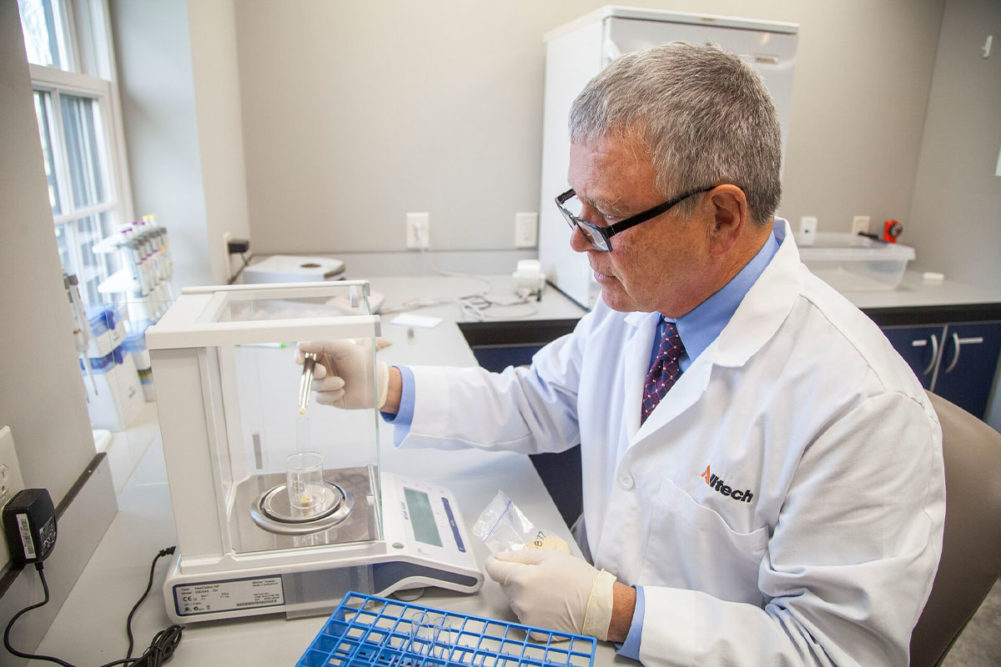NICOLASVILLE, KY. — When it comes to protecting pet food against mycotoxin contamination, the stakes are high. Aflatoxin has been a key culprit of several recalls in years past, and its presence in a finished product could compromise both pet health and a brand’s reputation.
The best way to safeguard against deadly mycotoxins is, “Test, test, test,” according to John Winchell, global RAPIREAD administrator for the Mycotoxin Management Team at Alltech, a global animal health company that produces specialty ingredients, premix, supplements, feed and biologicals.
“I think one of the biggest things that we can do as an industry to protect our commodities and our food safety is to make sure that we have a robust testing program put in place, from the farmstead level up to the supplier level and through the feed production level,” Winchell said. “…If you don’t test, you don’t know what issues you could potentially have.”
What are mycotoxins?
Mycotoxins are toxins released by certain fungi or molds. Grains and dried beans are particularly vulnerable to these molds and, therefore, mycotoxins. According to the FDA, these fungi typically grow on crops and can also manifest during storage. Mycotoxins are common in many farm environments, and they can survive in many places and on many different types of feed sources.

Aflatoxin is top of mind in the pet food manufacturing space, and is also one of the most tested-for mycotoxins around the world.
| Source: ©DULE964 – STOCK.ADOBE.COMPeople and pets that consume food containing mycotoxins can become sick, but pets are particularly at risk because they are typically fed the same diet day in and day out. Common symptoms of mycotoxin illness in pets include sluggishness, a loss of appetite, vomiting, jaundice and/or diarrhea, according to the FDA. Long-term effects, such as liver issues and even mortality, could also occur as a result of ingesting a high level of mycotoxins.
Corn, rice, wheat and other grains including milo, barley and ancient grains, make up a significant portion of raw materials used to produce commercial dog and cat foods in the United States. These ingredients are also at risk for mycotoxins, making it crucial that raw material suppliers and finished goods manufacturers alike test for mycotoxins to avoid selling contaminated products that could have devastating effects to pet health, not to mention a brand’s reputation.
According to the 2020 Pet Food Production and Ingredient Analysis joint report by the American Feed Industry Association’s (AFIA) Institute for Feed Education and Research (IFEEDER), Pet Food Institute (PFI) and North American Renderers Association (NARA), corn was the most-used farm and mill-based ingredient in dog and cat food in terms of volume in 2019, with roughly 1.96 million tons purchased for use in these diets. Other key grains used in pet food include wheat at 412.47 million tons in 2019, rice at 330.65 million tons, and barley at 110.92 million tons.
The prevalence of these grain-based ingredients in pet food makes mycotoxin detection and mitigation an essential piece of any manufacturer’s food safety program.
Mycotoxin mitigation
Alltech’s comprehensive Mycotoxin Management Program leverages several different technologies and capabilities across various feed manufacturing sectors to help suppliers and producers test raw materials for mycotoxins, determine mycotoxin risk against regional and seasonal factors, and ultimately protect their grain supply chains against food safety repercussions caused by mycotoxins.
The program utilizes a variety of field- and lab-based tools to collect and analyze data around mycotoxin levels in animal food ingredients. The RAPIREAD® device, which employs mycotoxin testing technology from Neogen®, offers a quick and centralized way for farmers to collect data in the field. The test provides results in three to five minutes, and all data is uploaded to Alltech’s Mycotoxin Management Portal to deliver actionable insights in real time.

The Neogen Raptor allows ingredient producers and farmers to collect real-time data in the field, which is then uploaded to Alltech's Mycotoxin Management Portal.
| Source: AlltechAs a complement to its field-based RAPIREAD tool, Alltech also operates a 37+® lab in Lexington, Ky., which has the capacity to collect feed samples and analyze them for up to 54 individual mycotoxins. These lab results are then uploaded to the Mycotoxin Management Portal.
The portal itself is designed to store mycotoxin testing data — from the Alltech 37+ lab, RAPIREAD inputs and several other tools offered by Alltech — in a centralized, virtual format and display that data in a way that generates insights for quality control teams, purchasing managers, formulators and nutritionists, farm managers and consultants.
The Mycotoxin Management Portal also arms producers with information about global mycotoxin trends, which is especially important for feed ingredients sourced abroad, and connects feed manufacturers with Alltech’s global network of experts to help them interpret results and determine what steps are necessary to safeguard product against mycotoxins.
Understanding risk
According to Winchell, aflatoxin, deoxynivalenol, ochratoxin, zearalenone and fumonisin are some of the most prevalent mycotoxin risks when it comes to pet food manufacturing. Aflatoxin is top of mind in the pet food manufacturing space and is also one of the most tested-for mycotoxins around the world, according to Winchell. Aflatoxin is a known carcinogen and can also cause liver and kidney damage.
Deoxynivalenol, otherwise known as DON or vomitoxin, can cause liver damage and gut health issues, while ochratoxin is particularly harmful for dogs, according to Winchell. The FDA keeps a watchful eye on aflatoxin, deoxynivalenol and fumonisin, with regulations and guidance levels in place for these mycotoxins.
“There’s a risk from traditional mycotoxins as well as newer mycotoxins — because the mycotoxin field is ever-evolving — and there are a lot of feedstuffs that we check and maintain to make sure we’re looking at mycotoxin risk comprehensively,” Winchell said.
But it isn’t enough to simply look at the levels of individual mycotoxins. As the industry’s understanding of mycotoxins expands, researchers are learning that groups of these toxins can work in tandem against health and wellbeing, even when individual levels are low.
“We look at individual mycotoxins, but there’s a lot of research out there that shows there is a synergy between these different mycotoxins,” Winchell said. “They don’t necessarily affect the same part of the animal or the same system within the animal, but they will work synergistically to affect different parts, which will in turn lower the immune system, or liver function, or kidney function.”
This is where Alltech’s Risk Equivalent Quantity (REQ) tool comes into play. According to Winchell, the REQ compiles peer-reviewed research on mycotoxins to determine the species-specific impacts of multiple mycotoxins on an animal’s health, including dogs and cats.

Alltech's RAPIREAD mobile app allows its clients to send test requests quickly, securely and on-the-go.
| Source: Alltech“Certain mycotoxins and certain combinations of mycotoxin levels will have different effects on different species — some will affect cats more than dogs, some will affect small animals more than large animals, and so on,” he explained. “…We might look at one mycotoxin that is relatively low, another that is moderate, and another that is low-to-moderate, but when you look at them altogether and combine their risks, that will raise the REQ level.”
Mycotoxin risk also fluctuates between seasons and depending on where the grain is grown and/or stored. Temperature, moisture and agronomical practices can all influence mycotoxin growth. Additionally, a 2022 paper published in Trends in Food Science & Technology concluded climate change could very well impact mycotoxin levels in animal feed.
With all these factors to keep up with, Alltech created its PROTECT® Calculator to consolidate this data and provide processors with the knowledge needed to make crucial decisions around mycotoxin risk.
“For example, we look at mycotoxin levels over time to see when risk waxes and wanes throughout the seasons and geographically,” Winchell said. “We have plenty of different modules within this platform to help all different types of producers because, at the end of the day, feed manufacturers are all looking for different things.”
As part of the company’s RAPIREAD platform, Alltech’s PROTECT Calculator offers estimations for impacts, performance characteristics and local market pricing, all in the context of arming companies with modern mycotoxin data to inform their mitigation efforts.
Making the dream work
The depth of Alltech’s mycotoxin expertise is part of the reason why the company can offer such a robust mycotoxin program.
“Everyone says they’re surrounded by the best in the industry — I think I’ve heard that probably a thousand times — but I can safely say that the different mycotoxin management people that I work with here at Alltech are some of the best I’ve ever worked with,” Winchell said.
Alexandra Weaver, Ph.D., global technical support specialist on Alltech’s Mycotoxin Management Team, developed the RAPIREAD platform and conducts analytics work behind the scenes. According to Winchell, Weaver’s education at North Carolina State University was focused on mycotoxin management, which makes her a wealth of knowledge on the subject, both for Alltech and its clients.People and pets that consume food containing mycotoxins can become sick, but pets are particularly at risk because they are typically fed the same diet day in and day out. Common symptoms of mycotoxin illness in pets include sluggishness, a loss of appetite, vomiting, jaundice and/or diarrhea, according to the FDA. Long-term effects, such as liver issues and even mortality, could also occur as a result of ingesting a high level of mycotoxins.
The team similarly benefits from the knowledge of Max Hawkins, also a global technical support specialist. Hawkins works predominantly on the ruminant side, but his expertise extends to other species as well.

From left: Alexandra Weaver, Ph.D., global technical support specialist; John Winchell, global RAPIREAD administrator; and Max Hawkins, global technical support specialist on Alltech's Mycotoxin Management Team.
| Source: AlltechAs the pet food manufacturing industry continues to pick up pace, real-time data and tech-enhanced solutions are becoming increasingly important to keep ingredient suppliers and processors informed and agile. From resource management to logistics to quality control, these advancements are permeating all corners of the industry, and Alltech is hard at work ensuring the level of insight can be generated and managed for mycotoxins as well.
“The Mycotoxin Management Program allows us to have real-time solutions and make real-time decisions,” Winchell concluded. “To me, that’s where it starts and that’s where it ends.”
For more information about the Alltech Mycotoxin Management program, visit knowmycotoxins.com.
Read more about pet food safety on our Operations page.





